The topic of last US conventional cruisers is a bit forgotten today, as they were designed during WW2 to improve existing ships ended as subclasses commissioned postwar, missing WW2 entirely yet having a relatively active career still, taking part in the Korean, and for some, the Vietnam War as well as the Cuba missile crisis blockade. These late subclasses concerned the Fargo class (Cleveland), Oregon City class (Baltimore) and present Juneau class (Atlanta class), and the Des Moines class released later (replacing the Baltimore as heavy cruisers) as well as the Worcester class (both combining AA and light cruisers) seen in 2023.
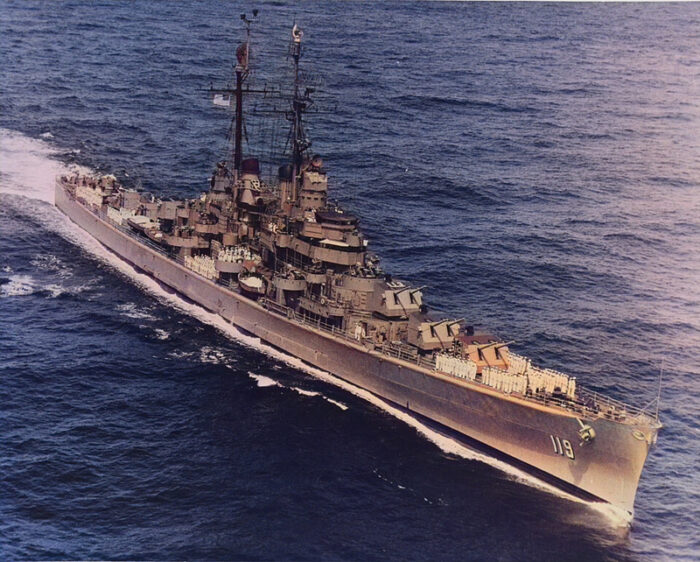
USS Juneau (CLAA-119 underway on 1st July 1951. IA colorized images src
The Juneau class were the last of the Atlanta class AA cruisers, which entered service just short after the attack of pearl harbour and if not a very successful design due to stability issues, they were based entirely on an excellent secondary dual purpose dual calibre, the legendary 5-in/38. So the concept was still useful. In 1942, it was decided to take into account all early lessons of combat service and massively improve the design, addressing all its shortcomings. This led to the Juneau class, many authors still making them a simple subclass related to the Atlanta and not separate. Here, we are going to see them separately, given the number of differences.
USS Juneau(ii), Spokane and Fresno were laid down respectively on 15 September 1944, 15 November 1944 and 12 February 1945 all at Federal, Kearny. Of all three subclasses, they were judged the least useful on the long run, but two saw action in the Korean War nonetheless. However, their narrow hull left little room for additions, notably better radars, due to stability issues and by 1949 already the 5-in/38, even radar-assisted and with fuses was considered more useful on smaller, cheaper platforms, such as the Gearing and Sumner class destroyers. The USN was already working hard to develop a first generation of anti-air missiles, and the AA cruiser concept looked outdated. Thus, they were decommissioned after just a few years of service in 1949, 1950 and 1955, but retook service for many more years after many modifications, in exercises with NATO for most of their career, until BU in 1961-73.
Introduction: The Atlanta class
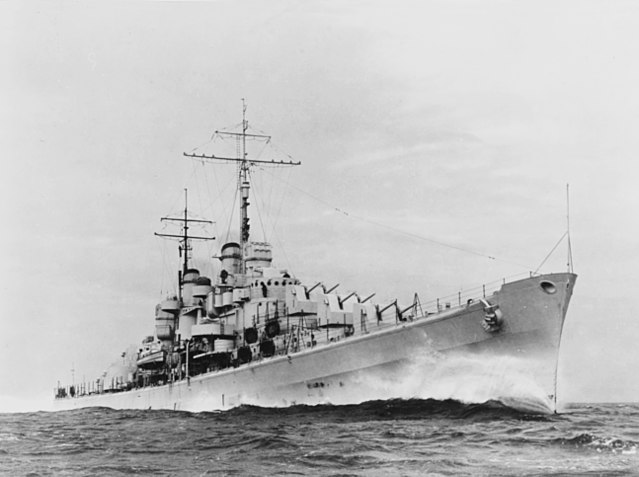
USS Atlanta in November 1941.
The idea of a dedicated AA cruiser was not new, as there has been many proposals both in the US and British Royal Navy. In Britain, this led to the controversial Dido class. The axis was more interested in “super destroyers”, to perform as scouts, such as the never-built German Spähkreuzer, Italian Capitani Romani class and Japanese Akizuki class. But the main incentive, as justified to obtained funds from the congress, was to replace the light cruisers of the Omaha class from the 1920s. The indeed arrived at a threshold of 20 years service, considered enough for a replacement. As we know, they were never as the war broke out. The Navy needed any hulls it could spare. The final concept for an AA cruiser was soon agreed by the admiralty board in 1939. On 20 June 1940 the Bureau of Ship, created by Pdt. Roosevelt as a fusion of BuC&R (construction and repair) BuEng (Bureau of Engineering) took over and completed the design of a lightweight dual-purpose ship armed only with the new standard 5-in/38 gun in semi-automated twin turrets, that looked very promising.
The early proposal was for eight dual-purpose turrets, a combination that could have sent 17,600 pounds (8,000 kg) of shells per minute on any enemy aircraft formation. They were the perfect instrument to guard aircraft carriers from close-in air attacks, a scenario well anticipated by the academy’s war game department. These ships counted for fire control on two Mk 37 fire control systems located on the centreline atop the superstructure, but no radar was envisioned. Worst still, the secondary AA battery only comprised what was available at the time, twelve 1.1-inch (28 mm)/75 calibre guns in three quad mountings without fire control associated… and optional Browning Cal.50 on pintles where space was available.
Needless to say this was less impressive, but USS Atlanta (CL-51 for “cruiser, light”), laid down at Federal Shipbuilding and Dry-dock Company, Kearny, New Jersey like her sister Juneau, was reused into commission on 24 December 1941, a mere couple of weeks after Pearl Harbour, her sister on 14 February 1942 armed the same way. Bethlehem Steel Corporation, Fore River Shipyard, Quincy, Massachusetts joined the effort and delivered San Diego and San Juan (commissioned Jan-Feb 1942), and Bethlehem Steel Corp. in San Francisco delivered the remainder CL-95 to CL-98, USS Oakland, Reno, Flint and Tuscon.
Many modifications were performed during the war, starting with the replacement of the “chicago piano” by a combination of Bofors 40 mm and Oerlikon 20 mm (respectively a Swedish and Swiss design itself derived from a German WWI project), notably six single Oerlikon 20 mm cannons as soon as they were available, and later Bofors to replace the quad 28 mm mounts. Given their weight, these were dual mounts, eight total, but all with their own fire control. The Oakland (CL-95) subclass was started in 1941-42 and completed in 1943-45 and already very different and modified compared to the first four ships. The first emergency was to solve the stability issue, which was close to dangerous.
The weight of all eight DP turrets was considered a real issue indeed. Topside weight plus lack of gunfire directors were heavily criticized, whereas future improvements, notably with radars and extra AA urged more radical weight-saving measures. Thus, two main gun turrets were deleted, from eight to six. Then, to compensate for their lack of anti-ship capabilities and add weight lower on decks, a couple of quad Mark 15 torpedo tubes were added (and later removed) and the depth charge projectors were also removed.
On the Oakland subclass, AA comprised now eight dual Bofors 40 mm guns, sixteen single Oerlikon 20 mm cannons and new radars were added when available, FD (Mk 4) fire control radar, SC-1 and SG search radar and from 1943 the improved Mk 12/Mk 22 combination. Also, the effectiveness of the main guns was multiplied by the new proximity fuses for AA fire. In 1945, the surviving Atlanta class (two were lost at Guadalcanal, including the famous five Sullivans brothers all on board USS Juneau).
In January 1946 USS Oakland and her sisters typically had, in addition to her six twin main guns, four in the centreline two aft on the wings, and no TTs, she now had four quadruple 40mm/60 Mk 2 mounts and two twin 40mm/60 Mk 1 AA mounts, then eight twin 20mm/70 Mk 24 Oerlikon mounts as well as the SC, SG, and two Mk 12/22 radars for main fire control. The solution to solve provisionally the top weight issue was to replace “C” and “X” (the two highest mounts) by Bofors, which by they was had an excellent fire arc. But it was recognized as a provisional solution and by late WW2 already, the Bureau of Ships worked for a more radical design solution to the issue, while returning to an eight main turret configuration.
Bureau of Ships Revised design (1942): Juneau class
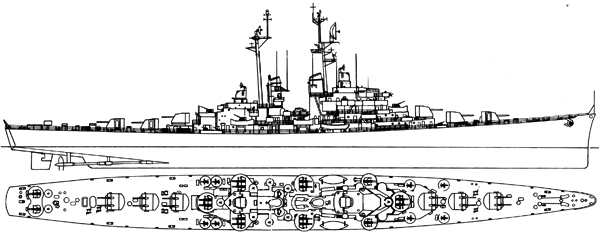
In light of war experience at Guadalcanal, the Bureau of Ships proposed to the admiralty a revised design, that would be attributed later hull numbers CL119-121 (USS Juneau(ii), Spokane and Fresno, in collaboration with the original builders of the Atlanta class, Federal, Kearny. This was a considerable redesign and like for the Cleveland and Baltimore subclass Fargo and Oregon City, they were intended as better distribute weight overall, improved massively on combat stability issues, provision for radar and extra AA additions, and give the latter a better arc of fire at all angles. This translated into many changes for the Atlanta class, with the first ship named in honour of the first cruiser lost in the class, USS Juneau now CL-119. She was followed by 121 (Spokane) and CL-121 Fresno. The inconsequential numbers were the result of Cleveland (and Fargo) classes taking numbers in between.
The first two were launched before the end of WW2, but completed in early 1946, and the last in November that year.
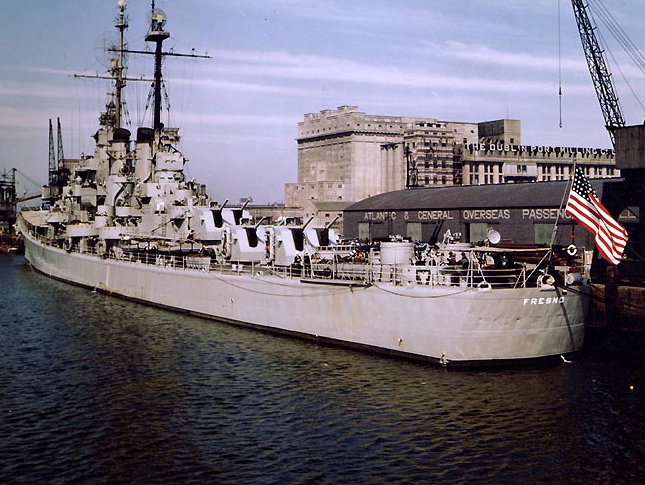
USS Fresno in Dublin, Ireland, May 1948
Design of the class
Hull and general design
The modifications consisted in essentially changing the turret placement to return to a combo of three axial turrets for and aft as initially planned. The second of each series was placed at deck level, and the last super firing pair, down by a full level. This greatly contributed to lower the centre of gravity and allowed to lower the whole bridge superstructure and fire directors as well. Given their poor protection and in light of the torpedo hits at Guadalcanal, watertight integrity was also deeply reworked. However, it was out of question to return to eight twin turrets as initially planned, as the two wing turrets only added to topweight issues and were swapped for Bofors quad mounts instead, shelving more weight.
The superstructure was simplified and made of even thinner plates, and that better distribution of weight enabled the installation of extra anti-aircraft mounts, like the Oakland class, four quadruple but six twin 40 mm Bofors, which was the “Kamikaze upgrade” ported already on the previous batch. This ensemble of six quad and six dual 40 mm (1.6 in) Bofors (32 in all) and 8 dual 20 mm (0.79 in) Oerlikon (16 in all) was a far cry from the first Atlanta class as completed in 1941.
Displacement rose to 6,718 long tons (6,826 t) standard, but 8,340 long tons (8,470 t) fully loaded versus 7,400 long tons (7,500 t) full load for the USS Atlanta, so a significant increase of 940 tonnes (2,07000 Ibs).
Dimensions remained unchanged at 541 ft (164.9 m) for a beam of 52 ft 10 in (16.1 m) and draft of 20 ft 6 in (6.2 m)
The crew rose to 742, versus 47 officers and 766 ratings for the Oaklands, and 35 officers, 638 ratings for the Atlantas. This was explained by the AA additions, since all 40 mm mounts needed a crew of 8-10 men each, plus radar and fire control operators. With an increase of 100+ men, they felt cramped and were not overly popular, despite some efforts in automation slightly reduced the crews from the Oaklands. The fire controls were upgraded to the latest FCS and radars.
Powerplant
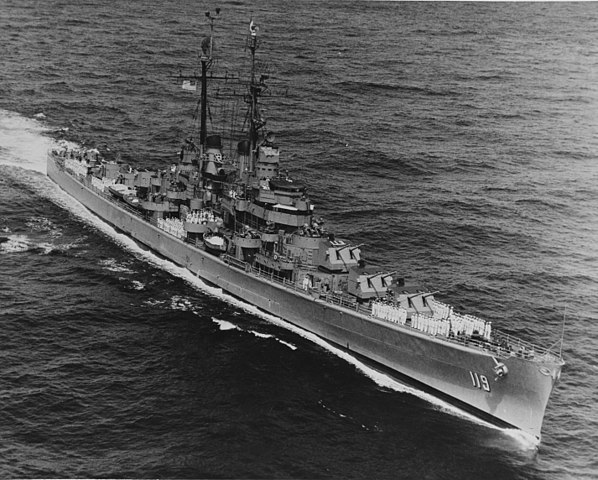
USS Juneau (CL-119) underway on 1st July 1951
There were basically no changes made there since the Atlanta class. The setup speed originally was 33 knots to escort and keep paces with the new fleet carriers of the Lexingtons, Yortowns, and later Essex and Independence class. Propulsion consisted in two shafts with three bladed bronze fixed pitch propellers, driven by two GE geared steam turbines, fed by four double-ended steam boilers working at 665 psi making for a total output for 78,749 hp (58.723 MW). The former powerplant had an output of 75,000 horsepower (56,000 kW) to compensate, notably thanks to new turbines. Top speed was less stellar given to the added weight, down to 32.7 knots (61 km/h), from an original 33.6 knots (62.2 km/h; 38.7 mph) of USS Atlanta on trials. Range was about the same at 6,440 nautical miles (11,930 km) at 20 knots (37 km/h), it was 8,500 nautical miles (15,700 km) at 15 knots (28 km/h) on the Atlantas.
Protection
There were some improvements in this chapter. The original design was on purpose never intended for a peer-on-peer engagement and solely to escort carriers, focusing on anti air-protection only, so focus was on protecting the decks, less so the belt or underwater bulk heading.
The Atlanta class had a belt reduced to just 1.1–3+3⁄4 in (28–95 mm) armour, with limited anti-torpedo longitudinal bulkheads behind and absence or armoured transverse bulkheads fore and aft. There was however compartmentation for the engines rooms and boilers, leading to two funnels far apart. The armoured deck was the best protected, at 1+1⁄4 in (32 mm) and the turrets were also protected by 1+1⁄4 in (32 mm), making them immune from any aircraft armament.
The conning tower was a survivor of other times, and was still made of 2+1⁄2 in (64 mm) walls.
The Juneau class had the same figures, but efforts were made to greatly improve underwater protection with larger and stronger longitudinal bulkhead to better absorb ad diffuse a torpedo hit, something that doomed Atlanta and Juneau. However, even with these modifications, little could be done against a “long lance” (type 93 torpedo). The true power of these was discovered postwar, so this was unknown to Bureau of Ships when modifying the design in 1942-43.
Armament
Fundamentally the only changes were an improvements over the sub-class Oakland, with more of the same for light AA, elimination opf the Mark 15 torpedo tubes and relocation of the main dual purpose 5-in/38 as seen above. The late 1944 “Kamikaze upgrade” ported on the Oaklands and surviving San Diego and San Juan was improved further on the Junau class.
5-in(127mm)/38 Mk 29
These twin mounts were the latest evolution of the dual-purpose turret, of which six were installed as said above in two deck positions for “X”, “Y” and “A”, “B”, so a full deck lower for the second turret of each group, and a deck lower for “C” and “Z” fore and aft, the third one. This slightly reduced their arc of fire, though. The former elevated position was given to quad Bofors mounts. The Mark 29 was common to the Oaklands and Juneau. The earlier Atlanta had Mark 29 as well, albeit improperly called Mark 12 in many sources. 450 rounds were likely carried or less (this was the Atlanta’s).
5-in/38 Mk29 stats
Weight Mark 29 Mod 1: 132,000 lbs. (59,875 kg).
Elevation: -15/+85 degrees at 15° second, training at 25° sec. 150° fire arc either side.
Gun length 223.8 in (5.683 m) for 3,990 lbs. (1,810 kg) without breech
Gun recoil 15 in (38 cm), barrel life 4,600 rounds
Rate of fire, 15-22 rounds per minute
Shell: 24.5 to 25 kgs (18-54 Ibs)/20.75 in (52.7 cm): AAC, Common Mk.32, “special common” Mk.38/46, RAO, Illumination, WP, Chaff.
Muzzle velocity with new charge 2,600 fps (792 mps), reduced 1,200 fps (366 mps)
Fuses
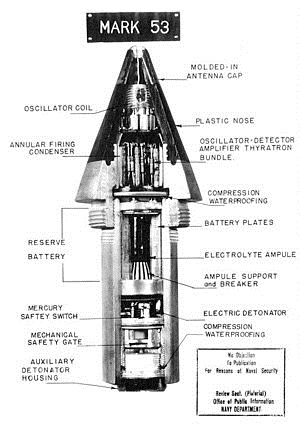 There was an originally mechanical Fuse Setter, with data given by the Mark 1 computer combined with the Mark 37 Gun Fire Control System (GFCS). In 1944, the arrival of the VT Fused (Proximity) AA projectiles was a game changer, making auto or manual settings redundant. Work started in 1942, as the CL-119 program was just worked out. Early models were tested at the Naval Proving Ground at Dahlgren, involving the efforts of many civilian and military personnel in the labs and particularly on the Potomac River Range. USS Cleveland tested pre-combat VT fuse in a test on 12 August 1942.
There was an originally mechanical Fuse Setter, with data given by the Mark 1 computer combined with the Mark 37 Gun Fire Control System (GFCS). In 1944, the arrival of the VT Fused (Proximity) AA projectiles was a game changer, making auto or manual settings redundant. Work started in 1942, as the CL-119 program was just worked out. Early models were tested at the Naval Proving Ground at Dahlgren, involving the efforts of many civilian and military personnel in the labs and particularly on the Potomac River Range. USS Cleveland tested pre-combat VT fuse in a test on 12 August 1942.
Contracts worth $85M for production were passed to Mare Island, which shipped the first 5,000 rounds. First combat kills were records in January 1943 already, with a 70% kill rate, which was insanely better than previous rounds. It was one of the greatest successes in USN and WW2 history, yet seldom talked about. A success in completely alleviating the disaster that was the Mark 14 torpedo. These fuses and better radar control made the 5-in/38 gun relevant until almost the end of the Cold War.
In conclusion:
“If a secret weapon is defined as a truly effective weapon on which absolute secrecy has been maintained, then the Navy’s VT, or proximity fuse, was one of the outstanding secret weapons of the war. It is not only an amazing anti-aircraft device, but has proved equally effective in land warfare.”
—Vice Admiral George F. Hussey, Jr.
Bofors Mark 1, Mark 2 40mm/60
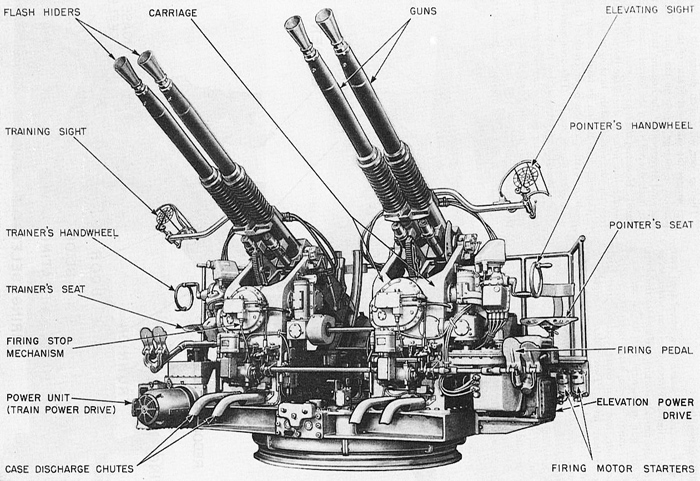
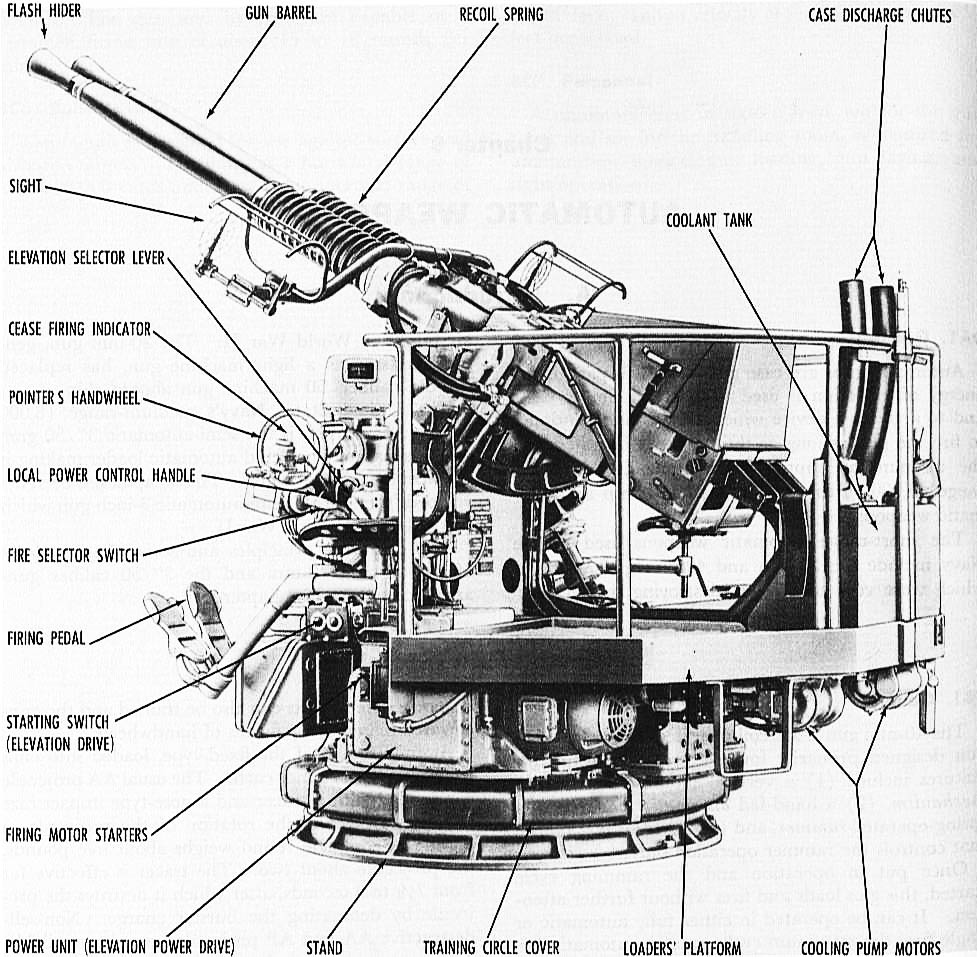
No need to present this legendary ordnance, still in service today, as ubiquitous as the browning calibre 50.
The Juneau class came out with six quad Mark 2 power-worked mountings (23,200-23,800 lbs (10,524-10,796 kg) with each barrel 1,150 lbs. (522 kg)). They were located in the axis fore and aft, replacing former 5-in/38 gun positions, and having the best fire arc perhaps of any US cruisers at the time, plus four wings mounts alongside the structure.
The four Mark 1 twin mounts weighted 9,800-13,000 lbs. (4445 – 5897 kg). Two were also located on the wings, forward, either side of the bridge and the last two on deck aft, close to the stern with an excellent arc as well. They all had the latest brand of fire control, individualized for each mount.
Dual Oerlikon Mark 24 L70
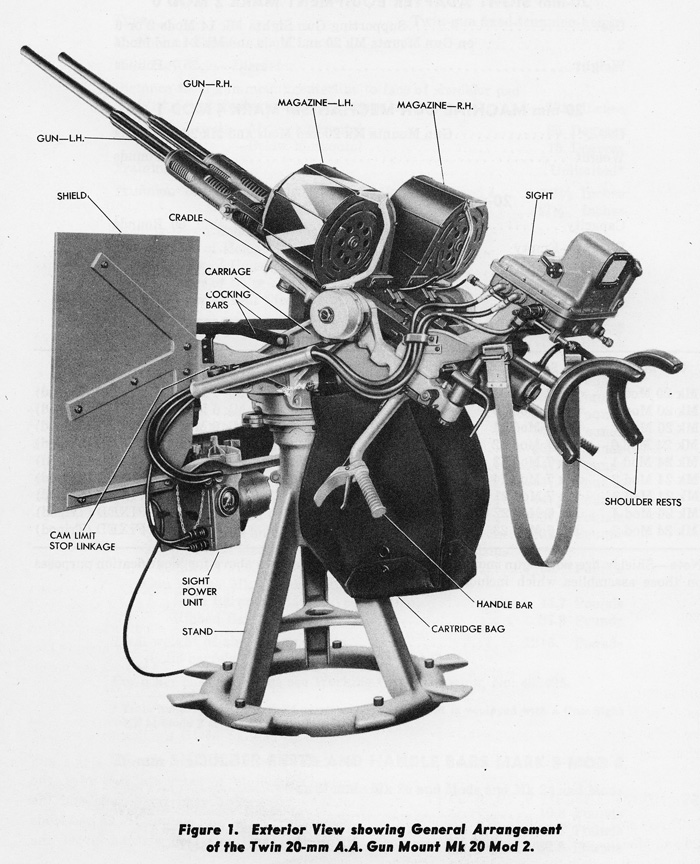
When it was discovered a second barrel could be mounted on the standard one-man single barrel mount, without much weight increase and crucially, no more space taken, gradual replacement went on all major warships in the USN inventory as part of the 1944 “Kamikaze upgrade”. However, by late 1944 it was recognized the 20 mm were no longer adequate to deal with these attacks and were removed, notably by single Bofors mounts in 1945 and postwar. The Oerlikons were eliminated for good in 1947-48.
Sensors (1946)
SC radar
ntroduced in 1942 this classic among classics 220 kW Air/Surface-search radar worked on VHF band:
PRF 60 Hz, Beamwidth 10–25°, Pulsewidth 4–5 μs, Range 48–120 km (30–75 mi), Precision 90–180 m (98–197 yd)
SG radar
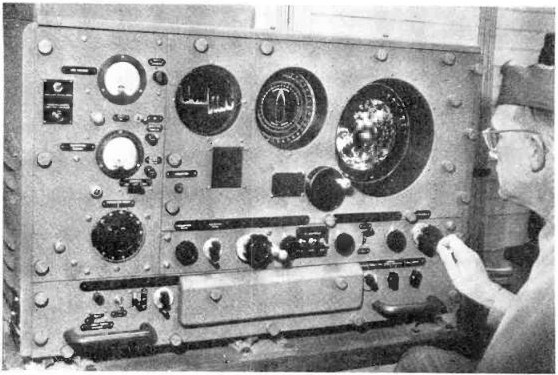
This 1942 Surface-search radar had a frequency of 3 GHz, PRF of 775, 800, or 825, Beamwidth of 5.6° (horizontal) and 15° (vertical)
Pulsewidth was 1.3–2 μs, it revolved at 4, 8, or 12 rpm, for a Range of 15 nmi (28 km; 17 mi), Precision 200 yd (180 m). Power was 50 kW.
Mk.12/22 radars
Operated in UHF band, mounted over the Mark 37 FCS.
Frequency: 920-970 MHz in UHF band. Beamwidth 10°
pulse repetition frequency: 480 Hz, pulsewidth (τ) 1 µs
peak power 100 kW, average 48 W. Range 22 NM (42 km) resolution 460 m
⚙ Juneau(ii) class specifications |
|
| Displacement | 6,500 tons (standard); 8,450 tons (Fully loaded) |
| Dimensions | 541 x 52 ft 10 in x 20 ft 6 in (164.9 x 16.1 x 6.2 m) |
| Propulsion | 2 shafts geared steam turbines, 4 × 665 psi (4,590 kPa) boilers: 78,749 hp (58,723 kW) |
| Speed | 32.7 knots (60.6 km/h; 37.6 mph) |
| Range | 6,440 nmi (11,930 km; 7,410 mi) at 20 knots (37 km/h; 23 mph) |
| Armament 1946 | 6×2 5-in/38, 6×4 + 4×2 40mmBofirs, 8×2 Oerlikon 20mm AA |
| Armament 1955 | 6×2 5-in/38, 7×2 3-in/50 AA |
| Protection | As Atlanta, see notes |
| Sensors 1946 | SC-2 ASR, SK-2 ASR (Fresno and Spokane), SG-1 SSR |
| Sensors 1955 | AN/SPS-6 ASR, SR-3 SSR, SP fighter-direction radar, Mk.56 FCS |
| Crew | 742 |
Cold War Modifications
In the cold war, at the time of their service in Korea, they had been modernized with new radars and FCS, and their light AA battery entirely replaced by seven twin 3 in (76 mm)/50 caliber Mark 22 anti-aircraft guns. These were very high velocity, medium range, radar assisted weapons, better suited to jets. The other ships of the former batches received this upgrade as well.
3-in/50 AA guns
Shell 12.13 in (30.8 cm)
Weight Mark 31 Mod 1: 24 lbs. (10.9 kg)
Elevation -15°/+85° at 30°/sec
Traverse 360° at 24°/sec
Rate of fire 40 rpm automatic (28 in 1968)
Muzzle velocity 2,700 fps (823 mps)
Antiship range (45°): 14,600 yards (13,350 m)
AA ceiling (85°): 30,400 feet (9,266 m)
Read More
 USS Juneau(ii) (1946)
USS Juneau(ii) (1946)
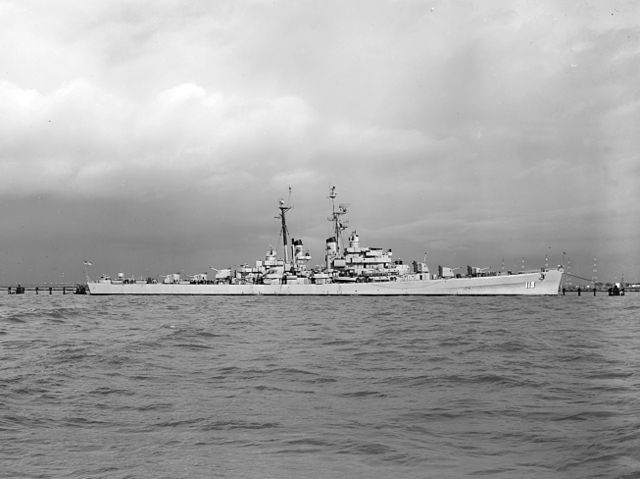
USS Juneau (Cl 119) in 1952
USS Juneau (CL-119) was the first of the second, heavily modified batch. She was laid down in September 1944, launched un July 1945, but construction was halted as the war ended, pending her fate. She was finally completed and commissioned on 15 February 1946, spending this year in operations along the Atlantic seaboard and Caribbean, and was deployed three times in the Mediterranean in 1947. Not only that, but she sailed from New York on 16 April 1947 to join the 6th Fleet at Trieste, arriving on 2 May where she took part in the “Trieste crisis”, tensions over ownership of the area between Italy and Yugoslavia. Likewise, she also made an extended and demonstrative tour of Greece, threatening communists very active in the country in near civil war. Furthermore, she was back to Norfolk on 15 November for training and returned to the 6th Fleet from until 3 October 1948 and until September 1949. She was reclassified CLAA-119 on 18 March 1949 and departed Norfolk on 29 November for the Pacific, where tensions rose in Korea.

USS Juneau anchored nearby USS Toledo at Yokosuka in 1950
She arrived at Bremerton on 15 January 1950, served along the Pacific coast became flagship in April 1950 for Rear Admiral J. M. Higgins (Commander Cruiser Division 5) before heading for Yokosuka, arriving on 1st June; She started patrols in the Tsushima Straits and when North Korea invaded the south on 25 June, USS Juneau was available to Vice Admiral C. Turner Joy for operations. She patrolled south of the 38th parallel, preventing enemy landings and made her first shore bombardments, taking place on 29 June at Bokuko Ko. She destroyed shore installations, and on 2 July sank three enemy torpedo boats near Chumonchin Chan. She also covered raiding parties along the coast. On 18 July, her force now bolstered by HMS Belfast, shelled enemy troop concentrations near Yongdok, almost wiping out entire units and nearly stopping the advance. After a halt at Sasebo Harbour to refuel and resupply on 28 July, she made a sweep through the Formosa Straits and joined the 7th Fleet at Buckner Bay in Okinawa on 2 August.
Flagship, Formosa Patrol Force on 4 August, she served there until 29 October and joined the Fast Carrier Task Force off the east coast of Korea. She later returned to Long Beach on 1 May 1951 for an overhaul of nine months. She received electronics upgrades with the Mk. 37, 56 and 63 fire control systems, and fourteen of the new long range, superfast 3-inch/50cal (in single and twin mounts). Likewise, she was sent back to the pacific in January 1952 and Hawaii, Yokosuka in April back to the Korean War. Furthermore, she conducted strikes along the Korean coast with carrier planes and was back to Long Beach on 5 November 1952. In 1953-54 she made training manoeuvres and operations with the Atlantic Fleet but also the 6th Fleet, alternating the Atlantic and Caribbean, and Mediterranean fleet.
Back to the East Coast on 23 February 1955, she was placed in reserve at Philadelphia NyD, on 23 March 1955. She was formally decommissioned on 23 July, attached to the Philadelphia Group of the Atlantic Reserve Fleet until November 1959, and stricken, sold in 1962. Her active career had only spanned nine years, but her concept was no longer relevant in the jet age. She also was too small to be converted, and in a general way, still relatively unstable and weakly built. Her sister ships did not fare better. However, at least she was awarded a battle star for her service in Korea.
 USS Spokane (1946)
USS Spokane (1946)
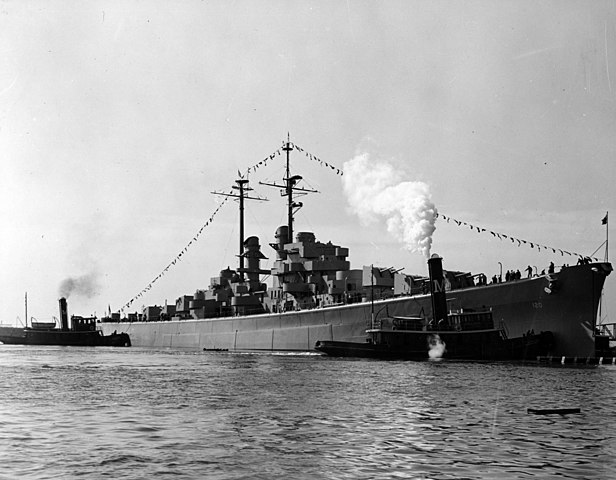
USS Spokane after launch, 22 September 1945
USS Spokane was laid down like her sister ships of the third batch at Federal, Kearny, on 15 November 1944. Launched on 22 September 1945 as the war has ended, she was completed nevertheless in May 1946. She made her shake down cruise between Bayonne in New Jersey, Brooklyn in New York and in June 1946, Guantánamo Bay in Cuba. She also trained for battle practice and gunners training on drones and towed targets. Back to New York on 11 September 1946 she was assigned to the 2nd Fleet, European waters, arriving in Plymouth on 7 October. She started a goodwill tour in January 1947, visiting Scotland, Ireland, Norway, and Denmark. She headed back home via Portugal, Gibraltar and Guantánamo Bay, taking part in 1947 fleet exercises. Furthermore, she was in Norfolk in March, taking part in more exercises in the Chesapeake Bay, and stopped for maintenance at the Brooklyn Navy Yard in September-October. Back to Norfolk, she took part in Navy Day celebrations on 27 October, and was prepared for a long deployment abroad.

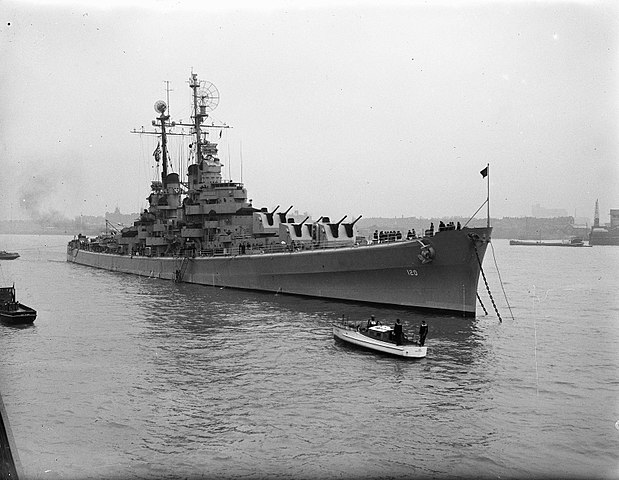
USS Spokane in Rotterdam, 1947 and 1950
USS Spokane sailed off Norfolk on 29 October to join the 2nd Task Fleet for tactical exercises off Bermuda until 8 November, and proceeded afterwards to Plymouth. She served with the Naval Forces, Eastern Atlantic and Mediterranean. She was present during the crowning celebrations of Princess Elizabeth II and later visited Bremerhaven in Germany by 24–26 November, back to Plymouth for more tactical operations in the North Atlantic, and stopped in February 1948 in Rotterdam, visited by Prince Bernhard on 17 February 1948. On 1st March, she sailed for Norfolk. By 18 March, she became CLAA-120 and resumed service on the eastern seaboard, until an overhaul and modernization at the New York Navy Yard (May-September 1948).
On 4 January 1949, she was sent to the Mediterranean. In January 1949, she was visited in Athens by King Paul and Queen Fredrika of Greece. She participated in war games with the 6th Fleet and visited Turkey, Italy, France, Sardinia, Tunisia, Libya, and Algeria, and back to Norfolk on 23 May 1949. She became a training ship for Naval Reserves, 4th Naval District and taking part in some exercises in the Virginia Capes area. On 24 October 1949, she was inactivated in New York, placed in reserve and then decommissioned on 27 February 1950. On 1 April 1966, she became AG-191 but stricken on 15 April 1972 and sold for BU in May 1973.
 USS Fresno (1946)
USS Fresno (1946)
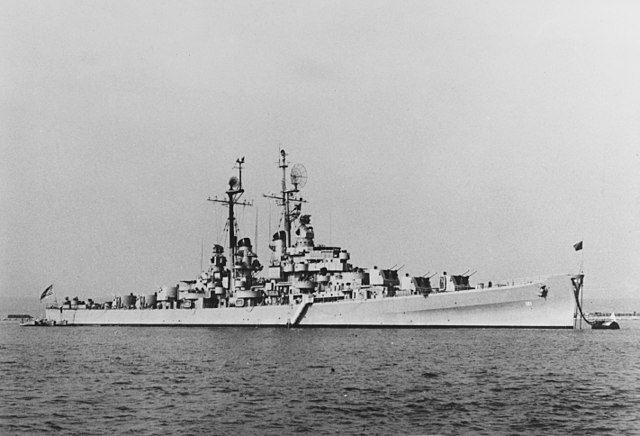
USS Fresno off Portland UK, Dorset, 14 August 1947
USS Fresno (CL-121) was launched on 5 March 1946 at Federal Shipbuilding and Dry Dock Company, Kearny in New Jersey. She was commissioned on 27 November 1946 (Captain Elliott Bowman Strauss) and after her shake down cruise in the Atlantic on 13 January-7 May 1947, she also visited the Caribbean, Montevideo, Uruguay, and Rio de Janeiro. On 1st August she sailed from Norfolk in Virginia and then headed to Europe, visiting ports of Northern Europe and the Mediterranean. Back in December 1947 in Norfolk, she was deployed again in Europe on 3 March until 19 June 1948, stopping at Amsterdam, Dublin, Bergen, and Copenhagen, and being based in Plymouth UK.
She was reclassified meanwhile CLAA-121 on 18 March 1949. She notably cruised to Prince Edward Island and Bermuda and was finally decommissioned at New York Naval Shipyard, on 17 May 1949. She was berthed at Bayonne, New Jersey in reserve until 1966 and stricken, then sold for scrap on 17 June that year. Not only that, but she did not earn battle awards like USS Juneau(ii) the only one in action in Korea, but instead the less prestigious WW2 Victory Medal and Navy Occupation Medal “EUROPE”. Her active service was only of three years in the US Navy… Again, like her sisters, she was no longer relevant in the Cold War context.

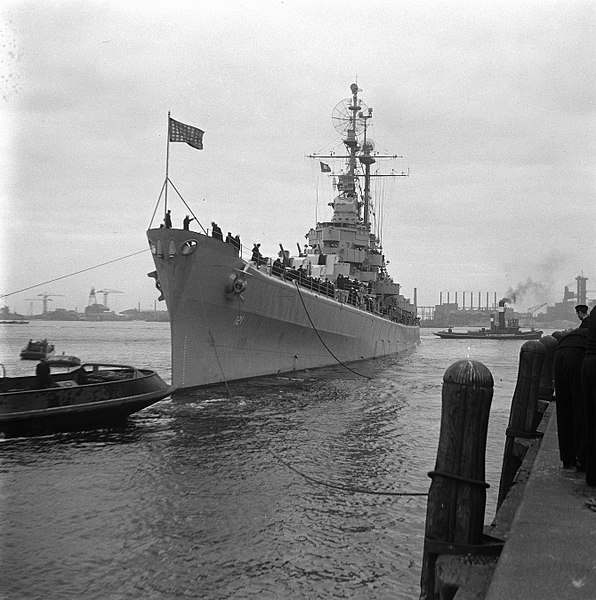
USS Fresno in Rotterdam, 1947
Read More/Src
Books
Friedman, Norman (1980). “United States of America”. In Gardiner, Robert & Chesneau, Roger (eds.). Conway’s All the World’s Fighting Ships 1922–1946. NIP
Friedman, Norman (1984). U.S. Cruisers: An Illustrated Design History. Annapolis: Naval Institute Press.
US Navy Light Cruisers 1941-45, Mark Stille.
Links
history.navy.mil/ cl119.htm
koreanwar.org/ uss_juneau.htm
history.navy.mil/ cl119-d.htm
fulkerson.org/ spokane
archive.ph/ history.navy.mil/ cl120
web.archive.org ussjuneau.net/
navsource.net CL119.htm
navsource.net CL120.htm
navsource.net CL121.htm
navalanalyses.com uss juneau cl-119
avsea.navy.mil Warfare-Centers NSWC-Dahlgren VT-Fuze
navweaps.com/ 4cm-56_mk12
navweaps.com 5-38_mk12
hazegray.org ca-cl2.htm
historyofwar.org USS_Juneau_CL119.html
usmhc.org/stories.php

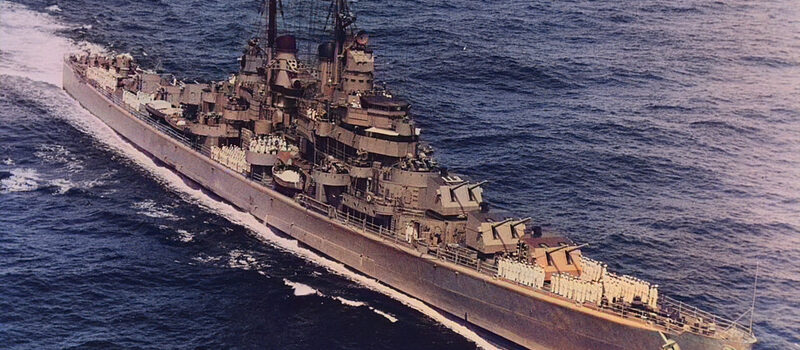

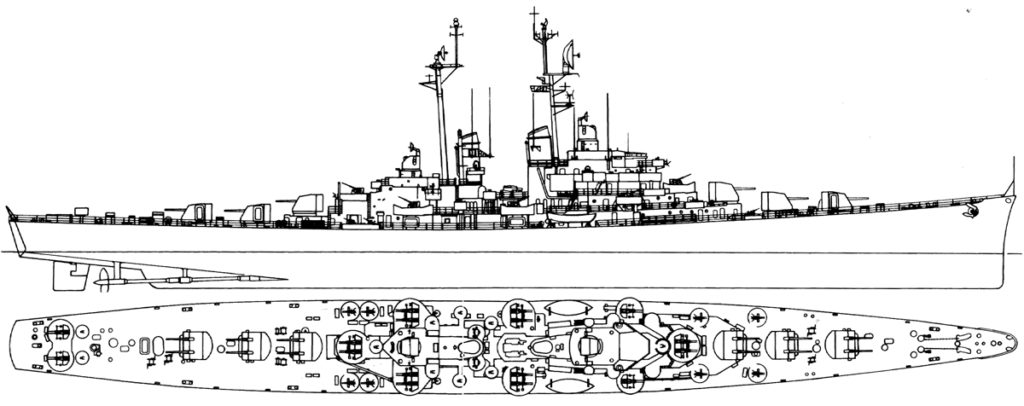
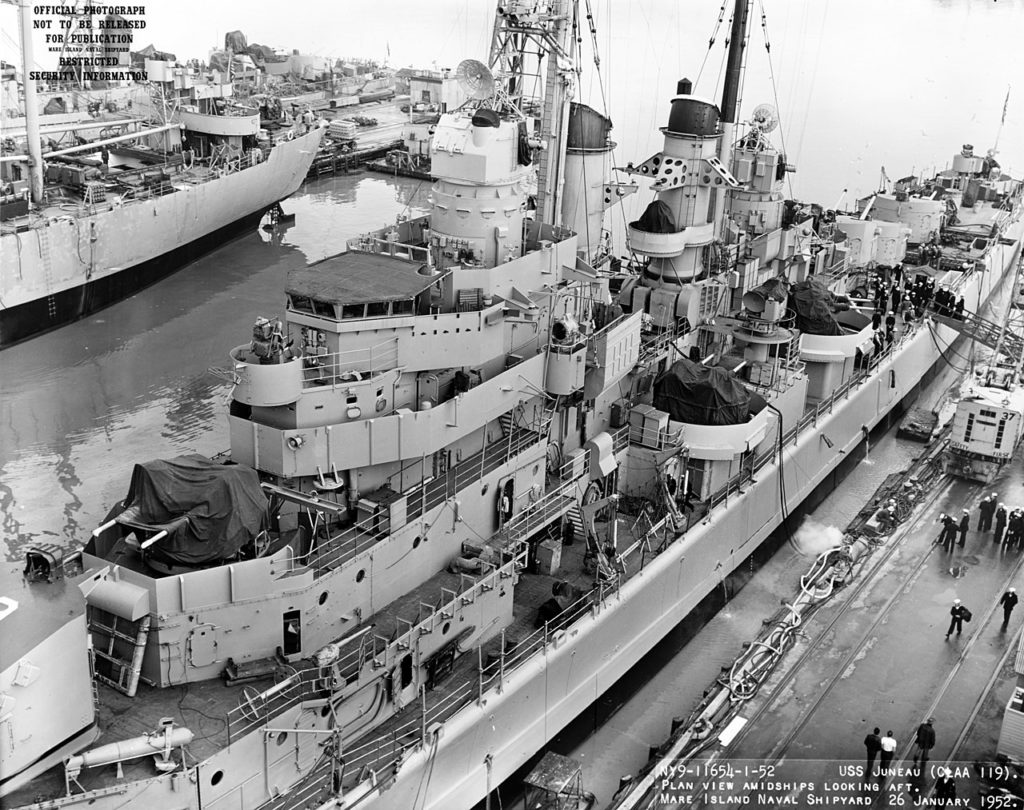
 Latest Facebook Entry -
Latest Facebook Entry -  X(Tweeter) Naval Encyclopedia's deck archive
X(Tweeter) Naval Encyclopedia's deck archive Instagram (@navalencyc)
Instagram (@navalencyc)





 French Navy
French Navy Royal Navy
Royal Navy Russian Navy
Russian Navy Armada Espanola
Armada Espanola Austrian Navy
Austrian Navy K.u.K. Kriegsmarine
K.u.K. Kriegsmarine Dansk Marine
Dansk Marine Nautiko Hellenon
Nautiko Hellenon Koninklije Marine 1870
Koninklije Marine 1870 Marinha do Brasil
Marinha do Brasil Osmanlı Donanması
Osmanlı Donanması Marina Do Peru
Marina Do Peru Marinha do Portugal
Marinha do Portugal Regia Marina 1870
Regia Marina 1870 Nihhon Kaigun 1870
Nihhon Kaigun 1870 Preußische Marine 1870
Preußische Marine 1870 Russkiy Flot 1870
Russkiy Flot 1870 Svenska marinen
Svenska marinen Søværnet
Søværnet Union Navy
Union Navy Confederate Navy
Confederate Navy Armada de Argentina
Armada de Argentina Imperial Chinese Navy
Imperial Chinese Navy Marinha do Portugal
Marinha do Portugal Mexico
Mexico Kaiserliche Marine
Kaiserliche Marine 1898 US Navy
1898 US Navy Sovietskiy Flot
Sovietskiy Flot Royal Canadian Navy
Royal Canadian Navy Royal Australian Navy
Royal Australian Navy RNZN Fleet
RNZN Fleet Chinese Navy 1937
Chinese Navy 1937 Kriegsmarine
Kriegsmarine Chilean Navy
Chilean Navy Danish Navy
Danish Navy Finnish Navy
Finnish Navy Hellenic Navy
Hellenic Navy Polish Navy
Polish Navy Romanian Navy
Romanian Navy Turkish Navy
Turkish Navy Royal Yugoslav Navy
Royal Yugoslav Navy Royal Thai Navy
Royal Thai Navy Minor Navies
Minor Navies Albania
Albania Austria
Austria Belgium
Belgium Columbia
Columbia Costa Rica
Costa Rica Cuba
Cuba Czechoslovakia
Czechoslovakia Dominican Republic
Dominican Republic Haiti
Haiti Hungary
Hungary Honduras
Honduras Estonia
Estonia Iceland
Iceland Eire
Eire Equador
Equador Iran
Iran Iraq
Iraq Latvia
Latvia Liberia
Liberia Lithuania
Lithuania Mandchukuo
Mandchukuo Morocco
Morocco Nicaragua
Nicaragua Persia
Persia San Salvador
San Salvador Sarawak
Sarawak Uruguay
Uruguay Venezuela
Venezuela Zanzibar
Zanzibar Warsaw Pact Navies
Warsaw Pact Navies Bulgaria
Bulgaria Hungary
Hungary

 Bundesmarine
Bundesmarine Dutch Navy
Dutch Navy Hellenic Navy
Hellenic Navy Marina Militare
Marina Militare Yugoslav Navy
Yugoslav Navy Chinese Navy
Chinese Navy Indian Navy
Indian Navy Indonesian Navy
Indonesian Navy JMSDF
JMSDF North Korean Navy
North Korean Navy Pakistani Navy
Pakistani Navy Philippines Navy
Philippines Navy ROKN
ROKN Rep. of Singapore Navy
Rep. of Singapore Navy Taiwanese Navy
Taiwanese Navy IDF Navy
IDF Navy Saudi Navy
Saudi Navy Royal New Zealand Navy
Royal New Zealand Navy Egyptian Navy
Egyptian Navy South African Navy
South African Navy






























 Ukrainian Navy
Ukrainian Navy dbodesign
dbodesign